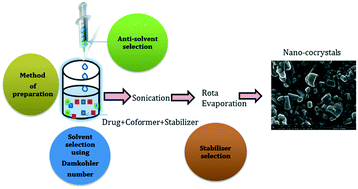当前位置:
X-MOL 学术
›
CrystEngComm
›
论文详情
Our official English website, www.x-mol.net, welcomes your feedback! (Note: you will need to create a separate account there.)
Preparation and optimization of nano-sized cocrystals using a quality by design approach
CrystEngComm ( IF 3.1 ) Pub Date : 2020/02/11 , DOI: 10.1039/c9ce01930h Pradip Thakor 1, 2, 3, 4, 5 , Balvant Yadav 1, 2, 3, 4, 5 , Sheela Modani 1, 2, 3, 4, 5 , Nalini R. Shastri 1, 2, 3, 4, 5
CrystEngComm ( IF 3.1 ) Pub Date : 2020/02/11 , DOI: 10.1039/c9ce01930h Pradip Thakor 1, 2, 3, 4, 5 , Balvant Yadav 1, 2, 3, 4, 5 , Sheela Modani 1, 2, 3, 4, 5 , Nalini R. Shastri 1, 2, 3, 4, 5
Affiliation

|
The present investigation was aimed at developing a laboratory-scale preparation technique for nano-cocrystals composed of a water-insoluble drug and a water-soluble coformer. The challenge was to prepare a nano-sized system while maintaining the integrity of the cocrystals. Carbamazepine–nicotinamide was selected as a model cocrystal for this study. An anti-solvent precipitation technique was investigated utilizing various solvents (ethanol, ethyl acetate, and acetone), anti-solvents (water, n-hexane) and stabilizers (Span 80, PVPVA-64, poloxamer-407) for producing nano-cocrystals. Preliminary screening was performed based on solubility and the Damkohler number which resulted in the selection of acetone as a solvent and n-hexane as an anti-solvent. The L-18 Hunter design was applied for studying the effect of five independent variables (type of stabilizer, concentration of stabilizer, sonication time, temperature and stirring speed) on the particle size (response variable). The experimental outcome indicated that the type of stabilizer and its concentration significantly affect the particle size of the nano-cocrystal formulation. The formulation containing 0.3% PVPVA-64 was found to be stable with the lowest particle size, i.e. D10 = 68.9 ± 9.5 nm, D50 = 138.2 ± 16.6 nm, and D90 = 260.3 ± 17.96 nm. Further, the optimized formulation was characterized by differential scanning calorimetry, powder X-ray diffraction, and ATR-FTIR spectroscopy. A decision tree to aid in the selection of solvent, anti-solvent and stabilizer for different nano-cocrystals is also presented which can be applicable for a wide range of drugs and coformers with different solubility.
中文翻译:

通过质量设计方法制备和优化纳米级共晶
本研究旨在开发一种实验室规模的纳米共晶体的制备技术,该纳米共晶体由水不溶性药物和水溶性共形成剂组成。面临的挑战是在制备纳米系统的同时保持共晶体的完整性。选择卡马西平-烟酰胺作为该研究的模型共晶。抗溶剂沉淀技术进行了研究使用各种溶剂(乙醇,乙酸乙酯和丙酮),抗溶剂(水,Ñ己烷)和稳定剂(司盘80,PVPVA-64,泊洛沙姆407),用于产生纳米-共结晶。根据溶解度和Damkohler数进行了初步筛选,结果选择了丙酮作为溶剂和n-己烷作为抗溶剂。L-18 Hunter设计用于研究五个独立变量(稳定剂类型,稳定剂浓度,超声处理时间,温度和搅拌速度)对粒径(响应变量)的影响。实验结果表明,稳定剂的类型及其浓度会显着影响纳米共晶制剂的粒径。发现含有0.3%PVPVA-64的制剂在最低粒径下即稳定,即D10 = 68.9±9.5nm,D50 = 138.2±16.6nm,D90 = 260.3±17.96nm。此外,通过差示扫描量热法,粉末X射线衍射和ATR-FTIR光谱法表征了优化的制剂。还提出了帮助选择不同纳米共晶体的溶剂,抗溶剂和稳定剂的决策树,该决策树可适用于具有不同溶解度的各种药物和共形成剂。
更新日期:2020-03-30
中文翻译:

通过质量设计方法制备和优化纳米级共晶
本研究旨在开发一种实验室规模的纳米共晶体的制备技术,该纳米共晶体由水不溶性药物和水溶性共形成剂组成。面临的挑战是在制备纳米系统的同时保持共晶体的完整性。选择卡马西平-烟酰胺作为该研究的模型共晶。抗溶剂沉淀技术进行了研究使用各种溶剂(乙醇,乙酸乙酯和丙酮),抗溶剂(水,Ñ己烷)和稳定剂(司盘80,PVPVA-64,泊洛沙姆407),用于产生纳米-共结晶。根据溶解度和Damkohler数进行了初步筛选,结果选择了丙酮作为溶剂和n-己烷作为抗溶剂。L-18 Hunter设计用于研究五个独立变量(稳定剂类型,稳定剂浓度,超声处理时间,温度和搅拌速度)对粒径(响应变量)的影响。实验结果表明,稳定剂的类型及其浓度会显着影响纳米共晶制剂的粒径。发现含有0.3%PVPVA-64的制剂在最低粒径下即稳定,即D10 = 68.9±9.5nm,D50 = 138.2±16.6nm,D90 = 260.3±17.96nm。此外,通过差示扫描量热法,粉末X射线衍射和ATR-FTIR光谱法表征了优化的制剂。还提出了帮助选择不同纳米共晶体的溶剂,抗溶剂和稳定剂的决策树,该决策树可适用于具有不同溶解度的各种药物和共形成剂。



























 京公网安备 11010802027423号
京公网安备 11010802027423号